Aaron Elson's Blog, page 14
December 24, 2015
Father Joe's "Most Memorable Christmas"
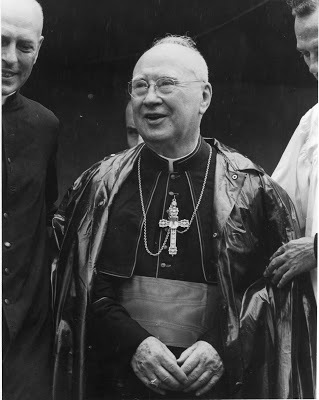 Cardinal Spellman in Vietnam. Father Joe is on the left.
Cardinal Spellman in Vietnam. Father Joe is on the left.What could cause this outpouring of our best except that deep within our spirits we sense that something of great joy has transpired. There is a realization that Christmas brings a new relationship with the source of our life. The Divine has become tangible in the form of a child. A great outpouring of God’s love occurred which touches and moves us at the core of our being. “The heart has its reasons the mind knows not of.” For us at Christmas, heart and mind both embrace a great reality, ever present, everlasting. And so the noisy, crowded aisles of stores and the quiet, reverent aisles of churches speak in response the same message of overflowing hearts.
That our memories are bright, then, is easy to understand, but choosing one is no less a task. I remember so vividly a Christmas Midnight Mass on an aircraft carrier at Cannes, France, in 1953. The decorated hangar deck was jammed with U.S. Navy men singing their hearts out in those first magic moments of Christmas, their voices traveling over the quiet waters of the anchorage to the Riviera hills. I remember clearly the special quality of Christmas in Japan with all the ships in Sasebo port for the holidays. We had to use a downtown theater to accommodate the crowd for Midnight Mass. An all-Japanese choir sang carols in that rarefied, angelic tone of a people who seek their God first in beauty. But though these are unforgettable, I must choose as the most memorable of all – Christmas 1965, in the land of beauty and terror, Vietnam.
So busy were the news media in reporting the terror that few found space for a description of its scene. Vietnam is ineffably beautiful. Mountains of every shade of green rise inland, peeping over each other’s shoulder until lost in a blue haze. Rivers emerge from the hills, and wind across flat green plains patched with rice paddies. Daytona-like beaches rim the land. Our tents were on the instep of a mountain so at night, rather than looking up, you looked directly at the stars. One Sunday morning as we admired this scenery from our shared jeep, Rabbi Reiner (on the way to his “weekday” service) remarked wistfully, “Everything is order except mankind.”
Christmas had to share in this paradoxical mixture of beauty and terror, joy and sadness, love and hate. Rifles stuck up from the shoulders of Marines kneeling in prayer or standing to sing “Silent Night.” This was to be their last Christmas in Vietnam, but Marine infantry casualties were very heavy. For many a white Christmas was only a dream, never to be. How would they return to America? The question was always there. Would it be on a seat in an airplane or in a box? The loneliness of perhaps never returning home and the thought of the impact of “the box” on those at home, especially for a father, is a more persistent feeling than fear.
At Christmas 1965, into this scene, came an old man who had traveled the fronts of three wars, Francis Cardinal Spellman. To some he may be a controversial figure in church history, but no one could deny his great affection for young Americans which motivated him to travel thousands of miles in all kinds of aircraft to assure the troops that they were appreciated and unforgotten. His heart went out to all those young men, too young to vote on the policies determining their sad fate. His message assuring them of the dignity of their lives was amplified by his frail condition. To think he had come so far even though his legs were too weak to climb unaided the platform to the altar.
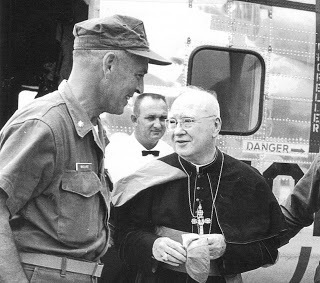 Father Joe and Cardinal Spellman in Vietnam We placed the altar on the same platform Bob Hope would use a few days later. It could be said we tested it for him. Early in the Mass, the jerrybuilt sound system went dead. Chaplain Morton, a Lutheran, and Chaplain Garrett, a Methodist, came to our aid. They raced to the compound at the end of the mud street of Hua Paat village, known as Dog Patch to the Marines, and came back with a portable lectern and mike in time for the Cardinal’s sermon. The Cardinal was equal to the task of singing the Mass and in a strong voice expressed his greetings to a grateful assembly. Shortly after he had given his blessing, one of his last, he was whisked off in a helicopter to Chu Lai Hospital to visit the wounded.
Father Joe and Cardinal Spellman in Vietnam We placed the altar on the same platform Bob Hope would use a few days later. It could be said we tested it for him. Early in the Mass, the jerrybuilt sound system went dead. Chaplain Morton, a Lutheran, and Chaplain Garrett, a Methodist, came to our aid. They raced to the compound at the end of the mud street of Hua Paat village, known as Dog Patch to the Marines, and came back with a portable lectern and mike in time for the Cardinal’s sermon. The Cardinal was equal to the task of singing the Mass and in a strong voice expressed his greetings to a grateful assembly. Shortly after he had given his blessing, one of his last, he was whisked off in a helicopter to Chu Lai Hospital to visit the wounded.The monsoon rains which had held off during the Mass started again. Protestant and Catholic chaplains had a cup of coffee together in the shelter of a tent and exchanged our own season’s wishes. We were all a bit exhausted. Conducting eve and midnight services and an early morning schedule in isolated areas had used up a lot of energy. It was afternoon now on that Christmas of intense joy and sadness. We would all remember that its light had shone brightly against the dark background.
The Vietnam War is far behind us, thank God. A prayer that our land will lead the way to peace and justice is on our lips with every Christmas.- - -Got Kindle? Foibles of Father Joe is available for a free download from Christmas Day until Dec. 29. Merry Christmas and a Happy New Year from Oral History Audiobooks!
Published on December 24, 2015 15:43
July 29, 2015
Now available, the Kassel Cassettes on MP3 CDs
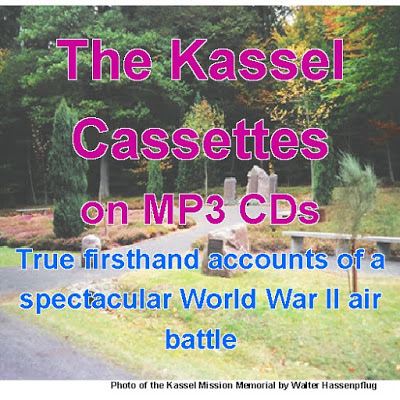
The Kassel Cassettes an audiobook on MP3 CDs
On Sept. 27, 1944, thirty-five B-24 bombers flew off course and were ambushed by more than 100 German fighter planes. The bombers had lost their fighter protection, and were easy targets for the swarming Fokke-Wulf 190s and Messerschmitt 109s.
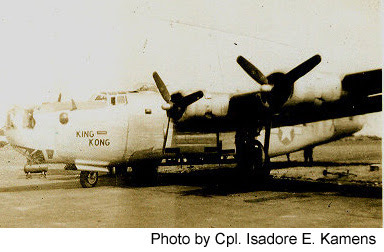 King Kong, pilot Jim Baynham, shot down on the Kassel Mission
King Kong, pilot Jim Baynham, shot down on the Kassel MissionNot that they were defenseless. Each B-24 Liberator was heavily armed with several .50-caliber machine guns that were blazing away during the battle. According to most accounts, the battle lasted less than six minutes, by which time the criews of "Mayday!" over the radio drew the cavalry in the form of the P-51s of the 361st Fighter Group. By the time it was over, 25 planes of the 445th Bomb Group were shot down. Many of the German fighter planes were shot down as well, and one American fighter pilot was killed.
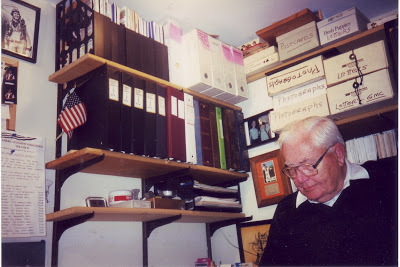 Kassel Mission Memorial Assn. co-founder George Collar in his "war room." Of the ten remaining Liberators, three crash-landed in Allied-occupied Europe, two reached an emergency landing base in England, one overflew the group's base at Tibenham, and only four made it back to base. I began interviewing survivors of the battle in 1999 after I visited a monument in Germany that has the names of every American and every German killed in the battle. The nonument, built by the Kassel Mission Memorial Association -- later called the Kassel Mission Historical Society -- with the help and inspiration of German historian Walter Hassenpflug, is a powerful testament to closure between former enemies.
Kassel Mission Memorial Assn. co-founder George Collar in his "war room." Of the ten remaining Liberators, three crash-landed in Allied-occupied Europe, two reached an emergency landing base in England, one overflew the group's base at Tibenham, and only four made it back to base. I began interviewing survivors of the battle in 1999 after I visited a monument in Germany that has the names of every American and every German killed in the battle. The nonument, built by the Kassel Mission Memorial Association -- later called the Kassel Mission Historical Society -- with the help and inspiration of German historian Walter Hassenpflug, is a powerful testament to closure between former enemies.
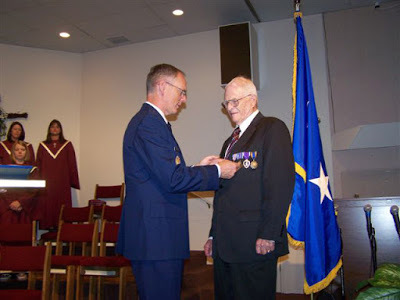 Pilot Paul Swofford receiving the Silver Star
Pilot Paul Swofford receiving the Silver Star"The Kassel Cassettes" on MP3 CDs is available in my eBay store for $14.95. It includes more than 22 hours of interviews with pilots, tail gunners, bombardiers, navigators, prisoners of war, and a widow and two sisters of fliers killed in the battle. These are MP3 CDs and will not play on most CD players or in older vehicles. Many newer cars have CD players that accommodate MP3s, and they will also play on virtually all computers and tablets and in CD and DVD players that specifically say they play MP3s. The set is also available as regular discs, but due to the fact that each regular CD holds at most 70 minutes of material, the entire set fills 21 CDs and is more expensive. Following is a sampling of tracks from the set which will provide an overview of the battle.
Track 1 (Paul Swofford)
Track 2 (Reg Miner)
Track 3 (Frank Bertram)
Track 4 (Henry Dobek)
Track 5 (George Noorigian)
Track 6 (Web Uebelhoer)
Track 7 (Malcolm McGregor)
Track 8 (Charles Graham)
Track 9 (George Collar)
Track 10 (Ira Weinstein)
Track 11 (Corman Bean)
Track 12 Sarah Schaen Naugher)
Track 13 (John Cadden)
Track 14 (Paul Swofford)
Track 15 (Erlyn Jensen)
Published on July 29, 2015 15:59
June 25, 2015
Remembering a hero of the forgotten war
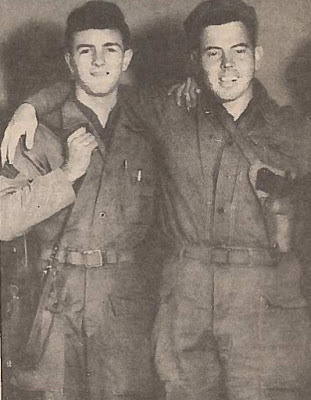 Sgt. Mathew Caruso, left, and Father Connie Griffin in Korea. Today (June 25) marks 65th anniversary of the beginning of the Korean War, when 75,000 North Korean soldiers poured across the 38th Parallel, captured the South Korean capital of Seoul and drove the small force of American defenders and Republic of Korea troops into a perimeter around the southern port of Pusan.
Sgt. Mathew Caruso, left, and Father Connie Griffin in Korea. Today (June 25) marks 65th anniversary of the beginning of the Korean War, when 75,000 North Korean soldiers poured across the 38th Parallel, captured the South Korean capital of Seoul and drove the small force of American defenders and Republic of Korea troops into a perimeter around the southern port of Pusan.Nineteen-year-old Marine Sgt. Mathew Caruso was at Camp Lejeune, N.C., where he lived off base in a small apartment with his wife of a few months, Betty. During the day Mathew was assigned as a chaplain's assistant.
Mathew's 1st Marine Division was activated and transferred to Camp Pendleton in California. There, he was assigned to a new chaplain, Navy Lt. (j.g.) Cornelius "Connie" Griffin, a 30-year-old Catholic priest. (Navy chaplains and medics, or corpsmen, are assigned to the Marines.) Betty Caruso returned to Rocky Hill, Conn., where she lived with her parents. She was pregnant, and had a feeling she would never see her husband again.
While the division hastily trained for overseas duty, Mathew helped build a temporary chapel with crates for pews in a quonset hut at Tent City 2 near the north end of Camp Pendleton.
Mathew and Father Griffin took part in the landing at Inchon and the fierce fighting that led to the recapture of Seoul. They also took part in the landing at Wonsan and the subsequent invasion of North Korea. During this time, Father Griffin would say in a newspaper interview, Mathew "saved my life" on numerous occasions.
Meanwhile, Mathew wrote home to his dad, Michael Caruso Sr., that he and Father Griffin often "prayed the rosary in foxholes." Mathew wrote that he looked forward to completing high school on his return -- he had dropped out in 1947 to enlist -- and getting a good job, now that he would have a family to support.
Late on the night of Dec. 6, 1950, during the breakout from the Chosin Reservoir, Mathew and Father Griffin were in an ambulance where Griffin was tending to a gravely wounded Marine. Outside the wind was howling and the temperature had dropped to around 20 degrees below zero.
The battle of the "Frozen Chosin", in which 300,000 Communist Chinese soldiers attacked the vastly outnumbered 1st Marine Division, along with some British commandos and United Nations troops, was one of the fiercest in Marine Corps history, earning a place alongside the World War II battles of Iwo Jima, Saipan, Peleliu and Guadalcanal.
The ambulance was in a long column on a narrow mountain pass that had come to a halt because a bridge was blown at Koto-ri, North Korea. Over the past few days the column had withstood several whistle-blowing, bugle-calling human wave attacks.
According to at least one account, as the column was bathed in darkness, the headlights on a nearby jeep went on, possibly by accident, illuminating the large red cross on the side of the ambulance. Suddenly a machine gun opened fire and bullets began penetrating the ambulance. Without hesitating, Mathew was heard to shout "Down, Father! Down!" He threw the chaplain to the floor of the ambulance and shielded him with his body.
Mathew Caruso was killed. Father Griffin was wounded in the chin and shoulder but survived. Over the wounded chaplain's protestations, Mathew's body was removed from the ambulance and buried in a mass grave that had to be blasted and bulldozed into the frozen earth at Koto-ri.
Six days later, his son, Daniel Caruso, was born in Rocky Hill.
Thirteen and a half months later, in a ceremony at the Groton submarine base, Mathew's posthumous Silver Star was presented to the toddler Danny, who was accompanied by his mother, who had remarried, and his grandfather.
When Father Griffin recovered, he oversaw the construction of the Caruso Memorial Chapel at Tent City 2. Sixty-four years later it is still a focal point of life at the Marine School of Infantry West.
John Caruso, one of Mathew's nine siblings, enlisted in the Marines after Mathew's death. He was at Camp Pendleton in 1955 when Mathew's remains were repatriated as part of Operation Glory, an exchange of thousands of sets of remains with the North Koreans. John Caruso was given the honor of accompanying his brother's body across country by train for burial in Hartford. Father Griffin, who would go on to become a monsignor in the Tucson, Ariz., diocese, came East and participated in the burial Mass.
Last year, Hartford's Bulkeley High School awarded Mathew a posthumous diploma in recognition of the fact that he hoped to complete his education. John Caruso, now a retired Hartford Superior Court judge, started a scholarship in his brother's memory, and organized a golf tournament to help fund it.
The first Mathew Caruso Memorial Golf tournament and dinner will be held at Wampanaog Golf Course in West Hartford on Monday (June 29). If you're not a golfer, you can come for the dinner, as several great silent auction and raffle prizes have been donated.
For information about the golf tournament, call John Caruso at 860-212-9092 or visit the Caruso Memorial Golf Tournament web site.
Published on June 25, 2015 18:42
May 22, 2015
Some Gave All: Memorial Day 2015
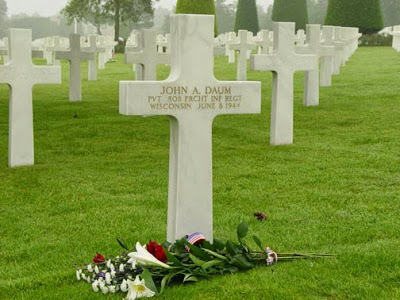 The grave of John Daum, 82nd Airborne, in Normandy. Photo by Bill Nation, whose uncle, a captain in the 508th Parachute Infantry Regiment, was killed in the Battle of the Bulge.
The grave of John Daum, 82nd Airborne, in Normandy. Photo by Bill Nation, whose uncle, a captain in the 508th Parachute Infantry Regiment, was killed in the Battle of the Bulge.Every Memorial Day I give some special thought to the interviews I've done in which veterans talk about members of their unit they were close to who never got the chance to come home from the war, or who came home in a casket years later. Here are some audio clips of veterans, and in one case a sibling, talking about those who went off to World War II and made the ultimate sacrifice.
Ed Boccafogli on Johnny Daum (From "The D-Day Tapes)
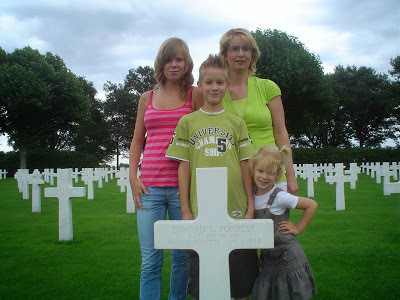 The family of Wil Goertzen at Ed Forrest's grave. Goertzen teaches history at Carbooncollege, a school in the Netherlands which "adopted" Ed's grave in the American cemetery at Margraten.
The family of Wil Goertzen at Ed Forrest's grave. Goertzen teaches history at Carbooncollege, a school in the Netherlands which "adopted" Ed's grave in the American cemetery at Margraten.Clifford Merrill on Ed Forrest
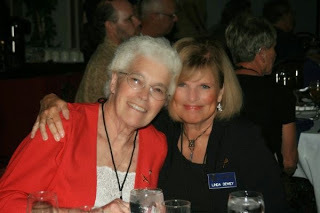 Erlyn Jensen, left, and Linda Dewey of the Kassel Mission Historical Society.
Erlyn Jensen, left, and Linda Dewey of the Kassel Mission Historical Society.Erlyn Jensen on her brother, Don McCoy (From "The Kassel Conversations)
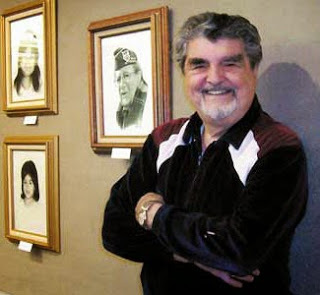 Karnig Thomasian with some of his artwork.
Karnig Thomasian with some of his artwork.Karnig Thomasian on Vern Henning (From "POW! Right in the Keister)
Karnig Thomasian on Vern Henning (Part 2)
Malcolm McGregor on Jack Dent (From "The Kassel Conversations)
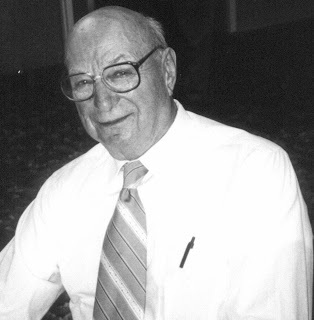 Ed Stuever
Ed StueverEd Stuever on Marion "Shorty" Kubeczko
Ed Stuever on Shorty (Part 2)
Ed Stuever on Shorty (Part 3)
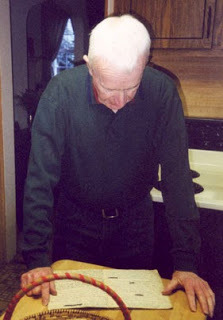 Tim Dyas
Tim DyasTim Dyas on visiting the father of a POW who died (From POW! Right in the Keister)Sam Cropanese on Lt. George Tarr (From "The Tanker Tapes)
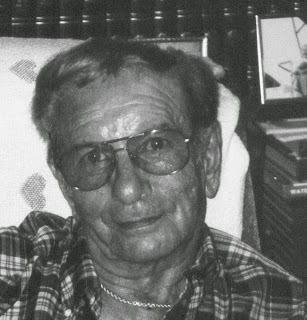 Joe BernardinoJoe Bernardino on tank driver Edmund Pilz (From "The Tanker Tapes)
Joe BernardinoJoe Bernardino on tank driver Edmund Pilz (From "The Tanker Tapes)
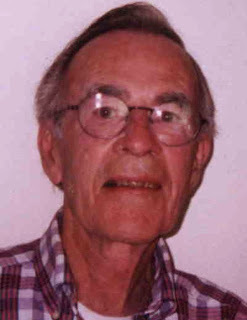 Chuck Hurlbut
Chuck HurlbutD-Day veteran Chuck Hurlbut on Tom Legacy (From "The D-Day Tapes)
1st Infantry Division veteran Valentine Miele on Omaha Beach (From "D-Day and the Bulge")
(For more excerpts and information, please visit my eBay store)
Published on May 22, 2015 16:41
December 24, 2014
Christmas in Kirschnaumen and other holiday stories
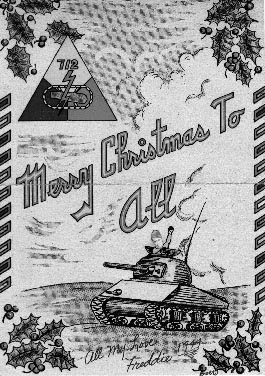 A card from Lt. Fred Lemm, 712th Tank Bn., to his wife.
A card from Lt. Fred Lemm, 712th Tank Bn., to his wife.Ira Weinstein of the 445th Bomb Group volunteered to fly a mission on Yom Kippur in 1944. It would have been his final mission, and he would be home in time for his wife's birthday on Christmas Day. Instead his B-24 was shot down over Kassel, Germany, and he became a prisoner of war. He did make it home for Christmas ... in 1945.
Tank driver Tony D'Arpino celebrated Christmas during the Battle of the Bulge by stringing machine gun bullets around a scrawny tree.
Bob Rossi, the loader in Tony's tank, recalled eating Thanksgiving dinner in the rain.
Far from home, holidays were especially poignant for the men and women fighting World War II. These are some holiday-themed audio clips from my World War II oral history interviews.
track 1 Major Forrest Dixon, 712th Tank Battalion, recalls Christmas shopping in Luxembourg.
track 2 Pfc. Bob Rossi recalls Thanksgiving of 1944.
track 3 Sarah and Jim Schaen get married on Christmas Day.
track 4 Bob Rossi and Lt. Jim Gifford recall Christmas in Kirschnaumen (France).
track 5 Ex-POW Jim Koerner recalls a Christmas Eve service in 1944.
track 6 B-24 bombardier Ira Weinstein is shot down on Yom Kippur in 1944.
track 7 Karnig Thomasian grows an Easter lily in a Japanese prison camp.
track 8 Corporal Jim Rothschadl, 712th Tank Battalion, recalls his father's love for the 4th of July.
track 9 Forrest Dixon's Christmas dinner is interrupted by an order from General Patton.
track10 T-4 Tony D'Arpino decorates a tree for Christmas.
track 11 Orlando Brigano and Paul Wannemacher recalls a Christmas Eve tragedy
track 12 More on the Christmas Eve tragedy.
Like audio such as this? Sign up for my email newsletter by sending me an email, and putting "email newsletter" in the subject line to get special offers and updates as well as the latest audiobooks in my ebay store and at oralhistorystore.com.
Published on December 24, 2014 19:31
November 10, 2014
On Veterans Day, 2014
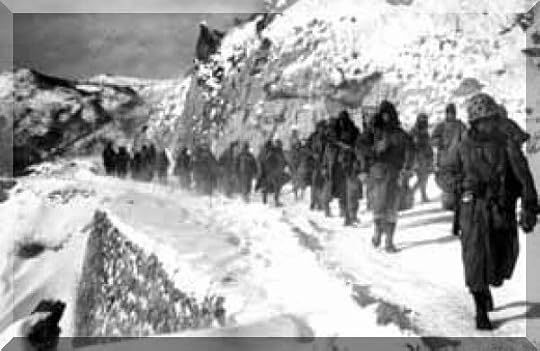 Marines withdrawing from the Chosin Reservoir
Marines withdrawing from the Chosin ReservoirA couple of entries ago I posted a poem from "A Rose Blooms Once," a book of poetry by Kester Hearn, who was a U.S. Navy chaplain with the 7th Regiment, 1st Marine Division in the Korean War. With the exception of four of the poems, the work is mostly light-hearted, spiritual, amusing, like this paean to a feline:
A Cat and Her Tailor
As I stooped to pet my kitty this thought came pouncing upon meWhat a lovely coat she's wearing it fits her to a T.It fit her as a kitten it fits her now she's grown.It is a seamless coat of beauty her Tailor is well known.Super Artist with His colors no two coats are just the same.Every coat is flawless fashion chic is she with Royalty.And when I quit my petting
my pet cat purred to me."Don't you wish you had my Tailor? You could beA well dressed cat like me."
So it seemed terribly incongruous, among Hearn's poems about the Korean War, to see in his comment following one of poems, written 33 years after the war, the use by this longtime Methodist minister of a pejorative word for a fallen enemy soldier.
In my earlier post I reprinted Hearn's poem "The Home-Coming" along with his comment following the poem. Today I'll present his three other poems about the war, which perhaps illustrate how for so many veterans, the images they've seen never really go away.
War Is Such a Lovely Thing
(My experience as a chaplain in the Korean War -- 1950-52.)
He gazed at me with glassy eye
As my battalion and I passed by. In that clobbered town he sat
With burned legs crossed, and leaning back
Following a napalm bomb attack.
Dead and swollen there he sat
Naked -- roasted -- bloody-- black
His buddies nearby in a stack
A gruesome scene, intense the stink,
Autumn trees lay among the foes
Wisps of smoke still slowly rose.
Somewhere back home this word would go
"It is with regret that we report
Your son -- your husband --,
Daddy Ling his ID says,
Was killed in action ten days ago."
His children do not understand
Why they'll never see their Dad again.
Thirty-three years have passed that day
Yet memory forbids him go away.
Ling still sits there by that tree
His glassy eyes still fixed on me.
To militarism the world must cling
War is such a lovely thing.
Hearn's comment following this poem: "Just after breakfast, August 9, 1985, I was thinking about the Korean War. As the First Battalion, 7th Regiment, First Marine Division, of which I was chaplain (Padre, they called me), was moving north, we came to the third hydro-electric power plant south of the Chosin Reservoir. Here we passed through a devastated town; and here I saw the burned, blackened and swollen North Korean or Chinese soldier sitting on folded legs, slightly leaning back. His glassy eyes were fixed on me and all who passed by. I was thinking of this gruesome scene when the thought came to me, "War is such a lovely thing." And this last line of the poem became its beginning and its title. Finished August 11, 1986. Written 33 years after the War.
Where People Used to Live
How lovely the celestial sight
With all its peaceful spheres so bright,
Except that small terrestrial ball
Where people used to live.
But ever since that mushroom day
When great white clouds blew man away
A shroud enfolds that scorched land
Where people used to live.
No ships arrive; no one's in sight
The traffic's dead, all days are night
Vast heaps of desolation lie
Where people used to live.
The earth still turns, sustains its blow
The tides, twice daily, ebb and flow
When Winter's done and sky is clear
Then joyful Spring will come again.
The earth will heal, life will resume
The birds will sing and roses bloom
On this old scarred and peaceful earth
Where people used to live.
Dumb Smoking Steel Monster
Dumb, smoking, steel monster --
It's done!
It knows not what's done, nor cares.
The recoil returns, the smoke
curls down.
Beyond a mountain a flash is seen
Fifteen seconds counted -- three miles away
It's done!
Words cannot tell but
It's done!
God's choicest handiwork who breathed
Loved and were loved lie scattered on
the ground.
Load in charges "six and seven," reach out
Ten thousand yards away the thunder says
again it's done!
When will God's will reach out and
be done
Beyond the mountains and every sea?
And the smoke cease curling from this thing's
unfeeling throat
And men rise above their ancient ways
To Christ -- and loving wisdom in every heart
be done?
Hearn's comment: I began this poem, Dumb, Smoking, Steel Monster, while resting in the 121st Army Evacuation Hospital at Hungnam, Korea, on November 7, 1950. It reflects what I saw and experienced on November 4. We had moved a few miles north of the third water power station from the Chosin Reservoir, and spent the night in a G--- mud hut. Our artillery was nearby and fired all night, shaking dirt from the ceiling. The water in our canteens froze solid that night. The "Dumb, Smoking Steel Monsters" were our own 105 Howitzers. After each firing, as the barrel of the 105 slowly slid back to position, the smoke -- lazily -- idiotically -- curled out the muzzle and down the muzzle. It appeared so dumb and unutterably stupid! From flashtime to report time and multiplying by 1,100 feet I roughly knew the distance shot. Charges "six and seven" meant the weight of powder used, and distance shot. This is my first poem; and I worked on it many hours aboard ship while I was coming back to the States.
Kester Hearn died on Dec. 6, 1997. I don't think it would be a reach for me to assume that he suffered from post traumatic stress disorder. Every veteran has his own way of dealing with the after-effects of war. For Kester Hearn, I imagine it was a combination of religion and poetry. The section of his book immediately following the four poems about the Korean War is a group of limericks.
"By George, I'll Wait"
There was an old man named Bumper
He was the world champion jumper
When he saw the Royal Gorge
He said, "By George,
I think I'll wait till next summer."
The Big Pitch
A world-famous cowboy named Newt
Rode Midnight out of the chute
Who pitched him so high
His head bumped the sky
He returned to earth by parachute
- - -
With that, I'll say thank you to all the veterans who've kept our country safe at so often a terrible cost.
Published on November 10, 2014 20:02
November 6, 2014
And here's to you, Joe DiMaggio
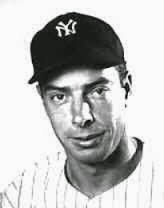 Joe DiMaggio Lately I've been researching the Korean War, in particular the Breakout from the Chosin Reservoir, for a book John Caruso and I are writing about John's brother, Marine Sergeant Mathew Caruso.
Joe DiMaggio Lately I've been researching the Korean War, in particular the Breakout from the Chosin Reservoir, for a book John Caruso and I are writing about John's brother, Marine Sergeant Mathew Caruso.In an online version of "Combat!" magazine, I found an article by Korean War veteran Stanley Modrak in which he described receiving the last rites from Father Griffin, the chaplain whose Life Mathew saved at the cost of his own.
I found a listing for Modrak in California, and reached his wife, who said he was in the hospital but that he would be happy to speak with me. A few hours later, while his wife was visiting, he called me back.
During our conversation, he mentioned that he wrote a book about his experiences in Korea. The book is called "Hostage of the Mind: A Korean War Marine's Saga of War's Trauma and the Battle That Followed Him Home."

"As each November nears and northern California's blue skies and wind-blown clouds flee, surrendering to a glowering, gray overcast," Modrak's description of the battle at Sudong-ni begins, "I recall a bleak fall of 1950 in North Korea. Disquiet memories intrude; discordant bugles blaring, echoing from hill to hill high above; sudden shock and fear as fingers of death clutch; a shadowy figure hovering."
Sudong-ni means "town by the river," Modrak said from his hospital bed when we spoke on the phone. He is recovering from heart problems at the age of 85. His battalion's commander, Colonel Homer Litzenberg, he wrote in his memoir,once said "The only Marines I want in my outfit are Purple Heart Marines." "As the crisp, darkening night air found the 7th Marines breaking out sleeping bags and preparing to sleep," his book continued, strains of 'Goodnight Irene' filtered through our bivouac area" via Armed Forces Radio Tokyo. "Meanwhile, unknown to the slumbering Marines, the Red Chinese 124th Infantry Division of General Sung's 42nd Field Army poised its 186th and 187th Regiments to hit Marine hill positions in a classic military double envelopment." "A double envelopment is usually pretty damn deadly," Modrak said on the phone. To make matters worse, he added, General Sung told his Red Chinese troops, "Kill these Marines as you would kill snakes in your homes." Despite decades of post traumatic stress, Modrak noted in his book with a sense of Marine pride that those snakes delivered a powerful bite. At 11:30 p.m., Modrak wrote, he was awakened by cries of "Here they come!" "We scrambled from our sleeping bags arming ourselves with M1 carbines and .45s. ... A blare of discordant bugles echoed eerily from hill to hill above. Soon shadowy forms rose from the murky darkness in the river bed to our left. As we let go with a fusillade of weaponry the forms faded into the deepening gloom. ... I marveled at the guts of our battalion officers as they stood tall in the valley's center, directing their Marines' defenses even though parachute flares exploding overhead bathed the tiny valley in a ghostly yellowish aura. "As mountain rivulets unleashed by a spring thaw form, multiply and then rush downhill following paths of least resistance, so too came the Red Chinese. Breaking past and veering around strong points, relentless bands of quilt-garbed Chinese infantry cascaded into, through and around Leatherneck hill positions intent on swarming into the valley floor battalion command posts." As the battle raged, a noncommissioned officer shouted "One of you, come with me!" "Marine discipline kicked in," he wrote, and he ran with the officer for 50 or 60 yards "that seemed like a hundred." as tracers lit up the night and the sound of gunfire was all around. "Miraculously" making it through the gauntlet of fire, Modrak "dove into the shadows behind a low stone wall." When the burst of three machine gun bullets struck, "slamming into my side and forearm," he wrote, "sound, feeling, disbelief all jumbled together in a disjointed sensation as I realized I was hit."He tried to shout "Corpsman" but "only a murmur emerged. Marines nearby took up the call as I slumped to the rocky earth. With consciousness rapidly fading, Colonel Litzenberg's words, 'Only Marines ... my outfit ... Purple Heart,' were my last thoughts. "Reviving sometime later in the still smothering darkness, I sensed a shadowy form hovering over me. Was it an enemy, a fellow Marine, or ...? Quiet, firmly enunciated words broke the chill night air: 'In nomine, Patris, et Filii, et Spiritus, Sancti, amen.' I then realized that the form must be our regimental chaplain, Father 'Connie' Griffin, pronouncing the Last Rites of the Catholic Church. Growing up through twelve years of Catholic schooling I knew full well their dire implications. 'Am I dying, Father?' I murmured. Passing out once again, I never heard any response. Awakening the next morning to daylight in a medical tent with other litter-bound wounded, it sure felt reassuring to be still among the living."
"Waking to daylight," Modrak wrote, "I found myself ... in the 1st Marine Division Hospital in Hungnam, North Korea. ... For some days I was only conscious and alert intermittently.
"Sometime in December, our hospital room had an unexpected and unusual pair of visitors. One afternoon two tall figures clad in heavy parkas and fur caps appeared. The famous baseball icon and New York Yankee superstar, Joe DiMaggio, known as the 'Yankee Clipper,' was at my bedside. Wow! Right in the middle of a “Hot War”; I couldn't believe my eyes. As a rabid baseball fan and admirer of DiMaggio, his appearance was a Korean War memory I'd never forget. "Joe was accompanied by 'Lefty' O'Doul, a baseball star in his own right and DiMaggio's friend and mentor going back to their San Francisco ball-playing days. Right here in North Korea and not too far from action, Joe and 'Lefty' were braving the bone-chilling North Korea winter to visit and cheer up American hospitalized military. This unselfish act greatly enhanced my admiration for Joe. I also knew that in the pantheon of Yankee greats only the 'Babe' ranked higher. "Asking how I felt, Joe handed me an authentic American League baseball autographed with his distinctive signature. Turning the ball over it read: 'To Stanley, best wishes – Joe DiMaggio.' "Overwhelmed, all I could do was murmur 'Gee. Thanks Joe.' After DiMaggio and O'Doul left, still not ambulatory, I gave the ball to our room corpsman to mail home for me to Pittsburgh. Big mistake! When I returned home some months later I learned that my wonderful trophy never arrived: What a disappointment! It probably was either stolen or lost in the wartime mail. As rabid baseball fans would understand, the loss bothered me for years after Korea. Having this uplifting experience in the midst of war and then the loss, I'm sure you can understand my feelings.* * * "Forward to a sultry L.A. summer in 1991, now a 39-year civilian after Korea and Honorable Discharge. The loss of the DiMaggio baseball still caused regrets over the years as the “Clipper” would be in the news from time to time. His marriage to Marilyn Monroe was prominent, then his devotion to her memory as he placed flowers on her gravesite every year on their anniversary. The much-valued baseball and its loss seemed to be another layer of depression added to the other somber and regretful Korean War memories. "My wife , Roulti, knew the story of the “lost trophy.” I had referred to it over the years and she realized how much it troubled me. Near my birthday in July of 1991 I checked the mail, finding a few letters, a bill and a small, square box. Curious, I turned it over to find that it bore the return address of the Oakland Athletics Baseball Club. Wondering what it could be, I eagerly opened the intriguing package. It held an authentic American League baseball. Turning the ball over, autographed words read: 'To Stanley, a replacement – Best Wishes, Joe DiMaggio.” Wow! After 41 years – what a birthday present! Happily showing the prized ball to my wife, she smiled with a “knowing” grin, admitting that it was her doing. "A week earlier I had mentioned to her that DiMaggio was to be honored at an A's game celebrating his 56-game hitting streak in 1941 -- a record still intact. Remembering the “lost ball” story and unknown to me , she had phoned the Oakland A's offices and spoke to General Manager Sandy Alderson. As it turned out Alderson was also a former Marine so that coincidence along with my wife's feminine persuasion struck a responsive chord with Alderson – and DiMaggio. "The treasured memento represents a happy closure to a long-ago disappointment and now bears an honored niche in our home. We have a time-honored saying in the Corps: Once a Marine, always a Marine. It certainly rang true with Sandy Alderson – Semper Fi Sandy!"- - -
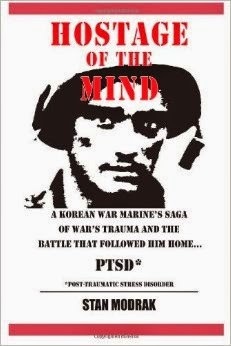 Hostage of the Mind ... at Amazon
Hostage of the Mind ... at Amazon
Published on November 06, 2014 21:07
October 27, 2014
The best $15.69 I ever spent
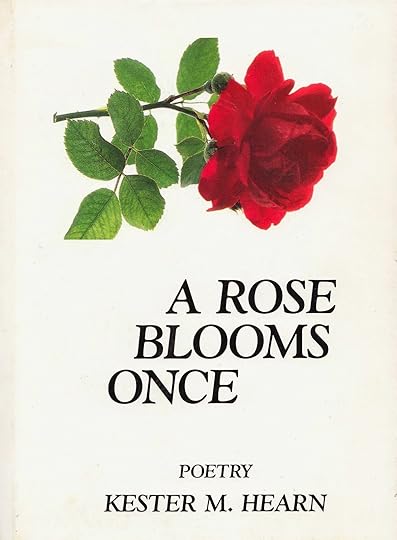
Lately I've been thinking about Eric Segal's opening line in "Love Story": "What can you say about a twenty-five year old girl who died?" I mean, what's the point of reading the book if you know she's going to die? On the other hand, everybody knows 15 minutes can save you 15 percent on car insurance, but who knew Pinocchio was a lousy motivational speaker? I mention this because I've been working on the story of Mathew Caruso, a young Marine sergeant who died saving the life of his chaplain in the Korean War. Everybody knows that, or at least they will before they open the book.
My research has taken me in many directions. Just the other night on YouTube I watched "Retreat, Hell!" in its entirety. It's a movie about the Chosin Reservoir campaign, made while the war was still in progress, like many of those great and patriotic World War II flicks that were made in 1943 and '44, some of them even in '42.
"Retreat, Hell!" touched many of the bases I've learned about in my research. It stars a young Russ Tamblyn as a 17 year old whose father gave him permission to enlist but had a heck of a time persuading his mother. He was a character much like Mathew, from a family with deep roots in the Marines. Tamblyn's character had a brother who was killed on Iwo Jima and another brother who was already in Korea. After freezing from fright in his first battle, he doesn't feel as if he's earned the right to visit his brother, who is in a nearby unit. Then he performs heroically in his second battle, and asks permission to visit his brother. Permission granted. He goes to the nearby headquarters and asks a gruff sergeant where his brother is. The sergeant says "Who wants to know?" Then he says the brother is around the corner. Tamblyn goes around the corner and there's a row of body bags.
The movie also has a scene where the young Marines jubilantly spread the word that they're going to be home by Christmas. And it has the trumpet blowing human wave attacks and the dead bodies of the Communist Chinese piling up on the hillsides just like in the firsthand accounts of the breakout from the Chosin Reservoir, perhaps the most epic battle in Marine Corps history.
The Russ Tamblyn character -- he's best known for his role in "West Side Story" -- reminded me very much of Mathew Caruso. But the movie missed one base which has been pertinent to my research: There was no scene with a chaplain.
In studying many accounts of the Chosin breakout, I've learned that there were three Navy chaplains attached to the 7th Regiment, 1st Marine Division. At least there were three at the beginning of the campaign, at Inchon and Wonsan and Sudong-ni, where Mathew's 7th Regiment was the first Marine unit to do battle with the Communist Chinese who had entered the war. Those three chaplains were Father Cornelius "Connie" Griffin, the Catholic chaplain with whom Mathew worked as his clerk and, in combat, his bodyguard; John H. Craven, a Southern Baptist who was the regimental chaplain; and Kester M. Hearn, a Methodist minister. All three of them had been in World War II, although Griffin was not a chaplain then.
By the time the Marines were breaking out of the Chinese entrapment, at places like Hagaru-ri and Koto-ri, there were only two chaplains with the regiment. And despite numerous accounts including an exhaustive U.S. Navy Chaplain Corps history and a history of the 7th Regiment that I was able to find online, there is no mention of what happened to the third, Kester Hearn.
And then Mister Google informed me that one Kester M. Hearn had written a book.
With all the newspaper interviews with Father Griffin and an extensive Chaplain Corps oral history of John Craven, I thought wow, I've hit the trifecta!
But was Hearn's book in Google Books? No.
Was it in Amazon's vast "marketplace" of used books? No.
Was it listed at Alibris?
Yowza Yowza, there was one copy listed! And it was only $11.70, plus $3.99 shipping. And that was it, except for five copies at various libraries in Texas.
So for $15.69 I ordered virtually the only copy of this book available anywhere on earth.
And then the book arrived.
It was a book of poetry. Children's poetry. Religious poetry. Cat poetry. Limericks. I daresay I was disappointed, and placed it on the back seat of my car.
A day later, I opened it up again. Maybe I overlooked something. And there it was, on Page 33, a section titled "War -- Absurd! Absurd!"
Kester M. Hearn -- the M. was for Maurice, which was my father's name; coincidence? I don't think so -- was born in 1908, which would have made him 42 years old in 1950 during the Chosin campaign. He received his Bachelor of Divinity degree in 1943 from Southern Methodist University. He served as a Navy chaplain in World War II and as a Navy chaplain with the Marines in the Korean War, after which he spent 32 years as a minister of the United Methodist Church before retiring in Fort Worth, Texas. He published his book of poems in 1993, and passed away in 1996.
There are four poems in the "War" section of the book. The first one I read was the second in the series. It's titled "The Home-Coming." It isn't for the faint of heart.
The Home-Coming
Ed's orders read, "You will report
for active duty on August four."
He kissed his wife, his daughter, son
and held them tightly one by one.
When time ran out he waved "Goodbye"
as long and far as he could see.
His family's future was rosy, bright
big things they'd planned after the fight.
With pack on back he boarded ship
and sailed on his far distant trip
He disembarked on day sixteen
in a foreign land he'd never seen.
He never had hunted or owned a gun
now over his shoulder an M-1 slung.
He saddled up for the front line
ignorant of all the hell he'd find.
Ed's hopes were high that Autumn day
the War, he thought, would go his way
And very soon he would return
to his family, his first concern.
Short hours before sunset that day
on bloody soil the soldier lay
A shrapnel slug had zeroed in
and blew away his face and brain.
From empty skull I hid my face
savage, brutal, mankind's disgrace.
The patriots who ordered him to fight,
ten thousand miles from this sight,
Dined in the Congressional Dining Hall
on gourmet food before their Ball.
By dog-tag Ed was identified
and by two pictures at his side
A picture of his precious Three
the other, where he longed to be.
He returned home in a sealed casket
with his headless body neatly in it.
Ed was met by broken hearts and streams
of tears and shattered dreams.
A Chaplain prayed, then taps was heard
"He gave his life??" Absurd! Absurd!
The poem, as are some others in the book, is followed by a comment: "This poem comes from another gruesome personal experience of mine while I was serving as chaplain of the First Battalion of the 7th Regiment of the First Division of the U.S. Marines in the Korean War, 1950-52. I came upon this Marine (Ed) soon after he had been killed. All but a little of the back of his skull had been blown away. That sight still hurts me to this day. As chaplain it was my job to write to the next of kin. A sad job. I began this poem November 17, 1985; completed it April 15, 1988. No, he did not give his life. He wanted to live as much as anyone. It was violently taken from him."
Thank you, Chaplain Hearn.
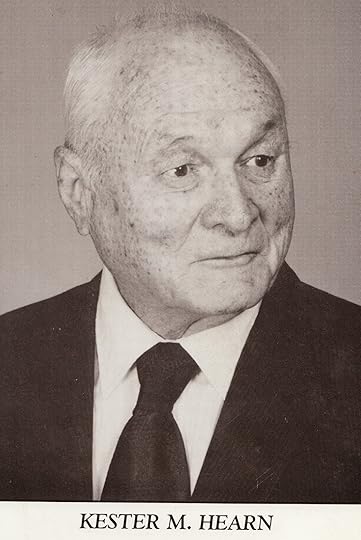
Published on October 27, 2014 20:43
September 27, 2014
On the 70th anniversary of the Kassel Mission

On the 70th Anniversary of the Kassel Mission
Aaron ElsonPresident, Kassel Mission Historical SocietySept. 27, 2014
Hard as it is to believe, today is the 70th anniversary of the Kassel Mission. Paul Swofford, one of a handful of pilots who brought his badly damaged B-24 back to England that day in 1944, left a message on my answering machine the other day. I could tell from the wavering in his voice how shaken he was by the memories, and yet he stressed how thankful he was that he had the opportunity to tell his story so that it would not be forgotten.Every veteran of the Kassel Mission, every widow or sibling of a flier killed in the battle, has his or her own personal thoughts as the 70th anniversary of the battle approaches. Some family members of Kassel Mission veterans are in Germany where the annual wreath laying ceremony carries extra significance because of the 70th anniversary.Thanks to the efforts of people like George Collar and Bill Dewey and Frank Bertram and Walter Hassenpflug, and the energy of the members of the Kassel Mission Historical Society, including Kassel survivors John Ray Lemons and Ira Weinstein, the sacrifice of the men lost on the Kassel Mission will be honored not only by the "next generation," but by the generation after that, as exemplified by social media wiz J.P. Bertram, and generations yet to come.As for me, I don't have a familial connection to the mission. It was while visiting the village of Heimboldshausen where a buddy of my father's was killed in World War II, that I met Walter and became fascinated by the history of the mission, some of which I've helped to preserve through a series of informal oral history interviews.So today I'm going to watch at least the beginning, and maybe a few scenes, of "12 O'Clock High," which to the survivors of the Kassel Mission is like "Patton" was to the veterans of my father's tank battalion, and I'll get all choked up when Dean Jagger sees that silly figure in the store window, and I'll listen for the drone of the returning B-24s. And I'll read the poem "High Flight," by John Gillespie Magee, a young Spitfire pilot who died in a training crash in 1941 at age 19, and and I'll remember George Collar telling me how disappointed he was as a youth because that was the War to End All Wars, and he feared he would never get the chance to be like his boyhood heroes.
High Flight
Oh! I have slipped the surly bonds of Earth
And danced the skies on laughter-silvered wings;
Sunward I've climbed and joined the tumbling mirth of sun-split clouds, – and done a hundred things
You have not dreamed of wheeled and soared and swung
High in the sunlit silence. Hov'ring there,
I've chased the shouting wind along, and flung
My eager craft through footless falls of air...
Up, up the long, delirious, burning blue
I've topped the wind-swept heights with easy grace
Where never lark, nor e'er eagle flew –
And, while with silent lifting mind I've trod
The high, untrespassed sanctity of space,
Put out my hand and touched the face of God.
For more information on the Kassel Mission, visit kasselmission.com
Published on September 27, 2014 10:24
August 13, 2014
Guest post: It's a Small World is not just a ride at Disney World
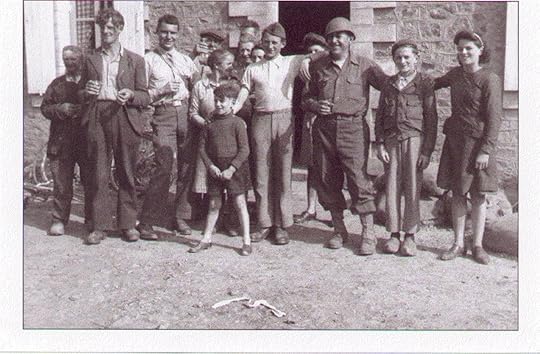 Joachim Ordoyne and the Cousins family, Périers, France, 1944
Joachim Ordoyne and the Cousins family, Périers, France, 1944IT’S A SMALL WORLD IS NOT JUST A RIDE IN DISNEY WORLDby Louis G. Gruntz, Jr. In the 1980s comic science fiction trilogy "Back to the Future," the plot centers around lightning striking the clock tower of Hill Valley city hall on November 12, 1955. A date before which the main character, Marty McFly, is born but with which he is inexorably connected and his time travels to the past and future are associated. His friend, Doc Emmett Brown, says “the date might hold some special significance, being the temporal junction point for the entire space-time continuum! Other than that it could just be an amazing coincidence.” It seems I also have a date that occurred three years before I was born in a town 4,500 miles away to which I seem to be inexorably connected that has a special significance or it could be just an amazing coincidence. The date is July 26, 1944; the place, Périers, France, where my father found himself situated during World War II. My father, a tank gunner in B Company of the 712th Tank Battalion, along with the 359th Regiment of the 90th Infantry Division, liberated Périers during the hedgerow fighting in Normandy. When a town’s train station was captured, the town was considered liberated -- my father’s tank was the first to reach the Périers train station.One of Dad’s good friends, Tullio Micaloni, was killed just outside of Perier as the Americans were advancing on Périers. The 359th sustained numerous casualties as well, including, Sgt. Arnold T. Marchand of G Company, from Minnesota, who was killed in action. As the ground troops were advancing on Périers, a squadron of P-47s was flying overhead providing aerial cover. One plane swooped down on a strafing run while the other maintained its flying elevation. When the diving plane returned to its flying elevation, tragedy occurred as both planes collided in mid-air. Both pilots, Ben Kitchens and Bert Espy, were killed. The planes crashed on a farm not far from Périers and the French farmers, the Cousins family, buried the bodies of both pilots.
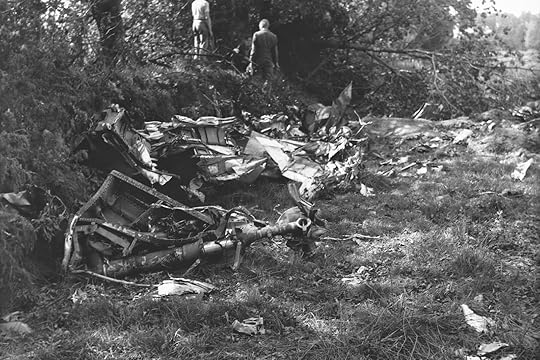 The wreckage of Bert Espy's P-47
The wreckage of Bert Espy's P-47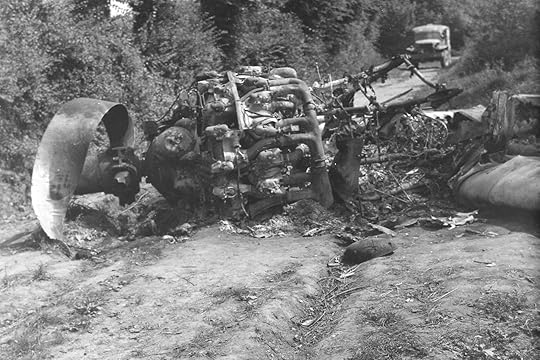 The motor of Ben Kitchens' wrecked P-47
The motor of Ben Kitchens' wrecked P-47Several months later, when the fighting had moved to eastern France, the U.S. Army sent several soldiers to recover the bodies of the downed pilots. One was a Colonel Moon, who led the operation, there was also an army photographer, Hugh Anderson, and a GI who spoke French to serve as an interpreter -- his name was Joachim Ordoyne. A 13-year-old boy named Henri Levaufre lived in Périers during this time. Always fascinated by the events affecting his town during WWII, he has become a noted historian in the area and is constantly seeking information surrounded Périers’ liberation. So how, you might ask, do all these events connect to a lawyer who born in New Orleans in 1947 two years after WWII ended? Well, in 2000, the association headed by Henri dedicated a monument depicting four soldiers to represent the hundreds of Americans killed during the liberation of Péeriers. One of the soldiers depicted was Tullio Micaloni. My father, mother, and two of my children traveled to Périers on June 6, 2000 for the dedication ceremonies.Learning that I was doing research for the 712th Tank Battalion Association, Henri asked me to help him locate an American soldier. Henri had found Colonel Moon and the photographer, Hugh Anderson, who had come to Périers in 1944, but could not find the interpreter, Joachim Ordoyne. Since Ordoyne was from Louisiana, Henri enlisted my aid. I told him I couldn’t make any promises; while Ordoyne sounded like a familiar Cajun name in Louisiana, it was neither a common name nor an uncommon one.
Henri stated, “But he speaks French.”
I replied, “Henri, that only narrows it down to about half of Louisiana’s population.”
Henri also provided several photographs in which Ordoyne was depicted In 2000 the internet was still somewhat in its infancy, and it was before the days of Facebook and Twitter. E-mail was just beginning to take hold as a popular way to communicate. When I returned home, I began an e-mail search and I located the e-mail address of a young lady named Ordoyne who was a student at Northwestern State University in Natchitoches, Louisiana. She responded to my e-mail but indicated that she did not think the Joachim Ordoyne I was searching for was a member of her family. She did indicate that there were a large number of Ordoynes living in Houma, Louisiana, a town approximately 60 miles southwest of New Orleans. I next contacted the Houma Courier newspaper and asked that they print a short human interest blurb with my name and telephone number stating that I was searching for this American GI from WWII. Several weeks later I received a call from a Mrs. Joachim Ordoyne from Gretna, Louisiana, the seat of government for Jefferson Parish, my home parish, which is just across the Mississippi River from my house. She indicated that her husband was an interpreter during the war. I became very excited as I began to tell her the details of the mission to recover the bodies of the pilots but my excitement was soon dashed when I could hear his voice in the background, telling her that he did not participate in any mission to recover bodies. She did, however, tell me that there were several Ordoyne families that moved to Ponchatoula, Louisiana, about 50 miles northwest of New Orleans. I immediately searched the telephone book for Ordoyne families in that locale and found two telephone numbers. I called both and was greeted by a telephone answering machine in each case. I left a brief message and asked the parties to return my call. That evening I received a call from a young lady who at that time was living in Virginia. She explained that she had returned home to Ponchatoula to celebrate her aunt’s 90th birthday, and my message was on her aunt’s answering machine. She indicated that her aunt was the last surviving member of their Ordoyne branch but the Joachim Ordoyne I described sounded like her late uncle. He was a fireman and he had died in the 1950s from a heart attack. I told her that I had photographs of the Joachim I was searching for. She said her aunt did not have a computer but if I could e-mail the photo to her friend who worked in downtown New Orleans, he could print it out and bring it to her in Ponchatoula. The next day she called back and said the Joachim in the photo was indeed her uncle who had passed away. I thanked her and was both happy and sad that I could report to Henri that I had located the interpreter he was looking for but that he was unfortunately deceased. The niece also indicated that Joachim’s son, Joachim Jr., would be back in town for the birthday; he had moved from Ponchatoula to North Carolina several years earlier. She indicated that she would have him call me when he was in town. The weekend came and went with no phone call from the son, but the next weekend I received a long distance call from North Carolina and the voice at the other end of the line identified himself as Joachim Ordoyne, Jr. As I thanked him for calling and immediately began relating the events of the mission to recover the bodies of the pilot, he interrupted me, saying, “Louis, you don’t remember me, do you? I go by my middle name Walter and you did some legal work for me about 20 years ago.” As soon as he said his name was Walter I immediately remembered him and realized why the name of Ordoyne seemed familiar to me. I immediately renewed our acquaintance. I was now even more excited about contacting Henri with my information on Joachim Ordoyne. Henri happened to be in the United States and was planning on traveling through North Carolina. I gave him Walter’s phone number and they were able to meet several days later to discuss Joachim Ordoyne, the American GI who was in Périers in 1944. My final connection was the Minnesota GI, Sgt. Arnold Marchand, who was killed on July 26, 1944. In researching my family genealogy, I discovered that one of my 10th great grandparents were Jakob Schiesser and Margreth Figi, both born about 1560 in Linthal, Canton Glarus. My mother was their 9th great granddaughter. Another of their 9th great grandchildren was Arnold T. Marchand, born in 1916 and died in 1944 in Périers, France, my 10th cousin once removed.
"It’s a small world" is not just a ride in Disney World.
Lou Gruntz is the author of "A Tank Gunner's Story: Gunner Gruntz of the 712th Tank Battalion"
Published on August 13, 2014 20:53



